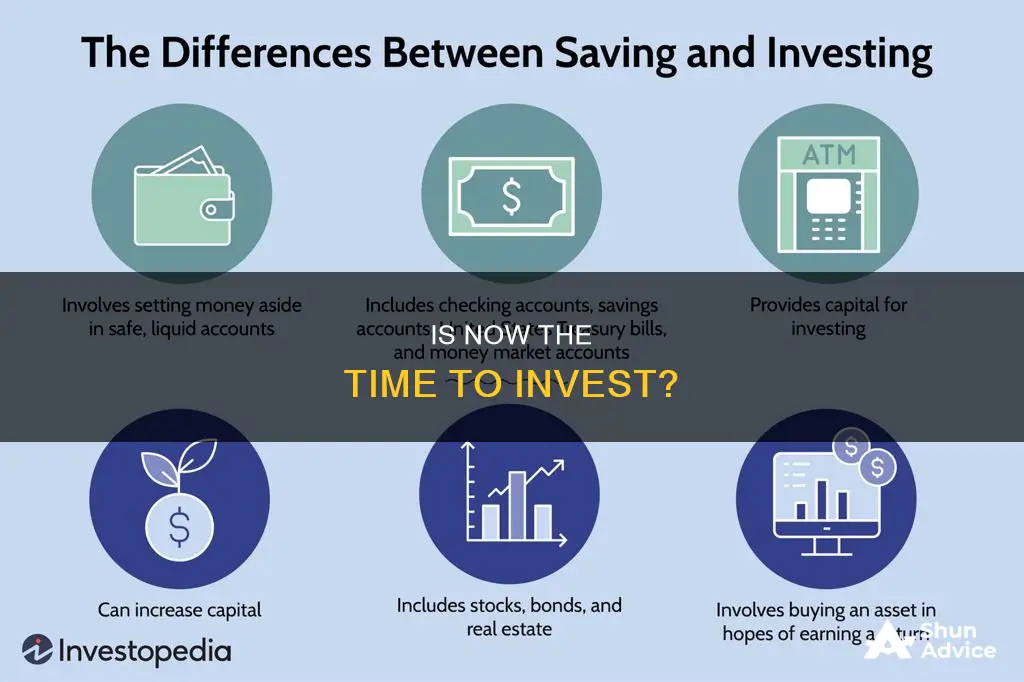
Investing in the stock market can be a scary prospect for some, especially when prices are high and a crash seems imminent. However, it's important to remember that, historically, the stock market has always recovered from crashes and continued to increase in value over the long term. So, if you're investing for the long term, now is as good a time as any to buy stocks.
That said, it's impossible to time the market perfectly, and trying to do so will likely lead to missed opportunities. A better strategy is to consistently invest a set amount at regular intervals, a technique known as dollar-cost averaging. This ensures that you take advantage of the market's gains while also keeping your average spending down by investing during dips.
When deciding whether to invest, it's also crucial to consider your financial goals and risk tolerance. If you're investing for a long-term goal like retirement, short-term market volatility may not be a significant concern. However, if you're saving for a more immediate goal, such as buying a home, you may need to adjust your investing strategy.
Additionally, it's essential to diversify your investments and focus on proven, high-quality stocks or funds rather than trying to pick individual stocks. This will help ensure that your portfolio can weather market downturns and generate solid returns over the long term.
| Characteristics | Values |
|---|---|
| Should you be investing right now? | Yes, if you have the savings to invest, feel ready to buy stocks, and don't need the money for at least five years. |
| Best investment options | High-yield savings accounts, certificates of deposit (CDs), bonds, money market funds, mutual funds, index funds, exchange-traded funds (ETFs), dividend stocks |
| Best time to buy stocks | There is no best time. If you're investing for the long term, it doesn't matter what time of day, day of the week, or month of the year you buy or sell stocks. |
What You'll Learn

Should I be investing in stocks?
Investing in stocks can be a great way to build long-term wealth. However, it's important to approach it with caution and to understand the risks involved.
When you invest in stocks, you're essentially buying shares of ownership in a public company. If the company performs well and grows over time, the value of your shares may increase, resulting in potential profits if you decide to sell them.
One of the key advantages of investing in stocks is the higher rates of return compared to more conservative investments like bonds. However, this comes with a trade-off, as stocks are also more susceptible to volatile ups and downs.
Before investing in stocks, it's crucial to consider your financial goals, risk tolerance, and time horizon. If you're investing for the long term, such as for retirement, allocating a significant portion of your portfolio to stocks can be a good strategy. On the other hand, if you're investing for short-term goals, you may want to avoid stocks altogether and explore other investment options.
Diversification is another critical aspect of investing in stocks. By diversifying your portfolio across different types of stocks and industries, you can reduce the impact of a single stock or sector experiencing a decline. It's recommended to hold between 20 to 30 stocks in your portfolio to achieve meaningful diversification and minimise risk.
Additionally, it's important to remember that investing in stocks doesn't require a large sum of money. Many brokerages allow you to open an account with no minimum balance, and some even offer fractional trading, enabling you to invest small amounts in a diverse range of stocks.
In conclusion, investing in stocks can be a powerful tool for building wealth over time. However, it's essential to understand your financial situation, conduct thorough research, and diversify your portfolio to manage risks effectively.
Investor's Losing Bet: Why Double Down?
You may want to see also

What are the best types of stocks to invest in?
When it comes to investing in stocks, there are several types to consider, and each comes with its own set of advantages and risks. Here are some of the best types of stocks to invest in:
Common Stock
Common stock is the most well-known type of stock and offers ownership in a company, along with voting rights on key matters. When you buy common stock, you're betting on the company's long-term success and growth, which will ideally contribute to higher share prices and dividends.
Large-Cap Stocks
Large-cap stocks are typically shares of well-established companies with market capitalisations of $10 billion or more. These companies usually have proven records of profitability, and the best of them are often referred to as blue-chip stocks. Examples include Apple, Microsoft, and Walmart.
Mid-Cap Stocks
Mid-cap stocks are shares of companies with market capitalisations between $2 billion and $10 billion. These companies are established but may still be in their growth phase, offering potential for meaningful price appreciation. Investing in mid-cap stocks can help diversify your portfolio beyond large-cap stocks.
Growth Stocks
Growth stocks are shares of companies that are expected to increase their earnings at a faster rate than their industry peers or the market average. They are often associated with innovative products or services and can deliver high returns. Examples include Amazon, Netflix, and Nvidia. However, growth stocks can be more volatile and prone to significant losses during market downturns.
Value Stocks
Value stocks are the counterparts to growth stocks and are considered less exciting but still rewarding. These stocks may be undervalued by the market or beaten down to low prices. Successful investors like Warren Buffett have built their wealth by identifying and investing in such stocks. Examples of value stocks include British American Tobacco and Reckitt Benckiser Group.
Foreign Stocks
Foreign stocks are issued by companies based outside your home country, usually taking advantage of robust capital markets while generating revenues elsewhere. Investing in foreign stocks can help diversify your portfolio and provide exposure to emerging companies globally.
Remember, there is no one-size-fits-all approach to investing in stocks. Each type of stock has its unique characteristics, and you should carefully consider your investment goals, risk tolerance, and time horizon before making any decisions. Conduct thorough research, analyse company fundamentals, and, if needed, consult a qualified financial advisor.
Investors: Money Masters or Risk-Takers?
You may want to see also

What are the alternatives to stocks?
There are several alternatives to stocks that you can consider adding to your portfolio. Here are some options:
Real Estate
Real estate is a popular alternative investment that provides ongoing cash flow through rental income and the potential for property value appreciation over time. There are several ways to invest in real estate:
- Real Estate Investment Trusts (REITs): These are companies that invest in income-producing real estate, such as apartment buildings, commercial properties, or timberland. REITs can be publicly traded on stock exchanges or sold through financial advisors.
- Residential or Commercial Rental Property: This involves buying property directly and collecting rent from tenants. It also comes with responsibilities like maintenance and repairs.
- Land: You can invest in land by renting it out for agricultural or forestry use or by purchasing land in areas that may be developed in the future.
Peer-to-Peer Lending
Peer-to-peer lending, or P2P lending, is a relatively new form of investment where you can join a pool of investors who loan money to individuals or businesses. P2P lending companies include LendingClub and Prosper. While there is a risk of default, P2P lending can offer higher returns than traditional savings accounts.
Gold and Precious Metals
Gold and other precious metals like silver and platinum are considered a tangible inflation hedge and a long-term store of value. You can invest in physical gold through bullion, coins, or bars, or indirectly through gold mining stocks, futures, options, or gold exchange-traded funds (ETFs). An allocation of 5% to 10% in gold is generally considered healthy for an individual's portfolio.
Owning Your Own Business
Investing in your own business can be rewarding and provide a steady income over time. Some businesses, like virtual or online ventures, have low startup and ongoing costs. You can also start a part-time business alongside your regular job to generate extra income.
Equity Crowdfunding
Equity crowdfunding allows you to own a part of a startup company by investing through websites like AngelList, CircleUp, SeedInvest, and Wefunder. This type of investment carries the risk of losing your money if the company fails, but it can also provide significant returns if the company succeeds.
Cryptocurrency
Cryptocurrency is a digital asset enabled by blockchain technology. While it is a risky and volatile investment, the values of cryptocurrencies are likely to increase as their functional uses expand. You can easily buy cryptocurrencies like Bitcoin through exchanges such as Coinbase.
Art and Collectibles
Investing in fine art and collectibles, such as valuable sports cards or memorabilia, is another alternative. While it can be challenging to value these assets accurately, platforms like Masterworks allow smaller investors to buy shares in high-value art and provide some liquidity to this typically illiquid asset class.
Toxic People: Invest Time Wisely
You may want to see also

What are the risks of investing?
Investing can be a great way to grow your wealth, but it's important to remember that all investments carry some degree of risk. Here are some of the key risks you should be aware of:
Market Risk
Market risk refers to the possibility of investments declining in value due to economic developments or other events that impact the entire market. For example, during an economic downturn, stock prices tend to fall, and investors may lose money if they need to sell their investments at that time.
Business Risk
Business risk relates to corporate decisions that can affect the value of your investments. For instance, a company's choice to expand into a new business area or merge with another company can impact its stock price.
Political and Currency Risk
If you own international investments, events within that country can affect your investment. Political decisions, such as changes in government policies, and currency fluctuations due to exchange rate movements, can influence the value of your foreign investments.
Liquidity Risk
Liquidity risk refers to how easy or difficult it is to convert your investments into cash. Some investments may be difficult to sell at a fair price or may require you to accept a lower price to find a buyer.
Concentration Risk
Concentration risk arises when you put all your eggs in one basket, so to speak. Investing in a single stock or a small number of investments increases your risk. Diversifying your portfolio across different types of investments, industries, and geographic locations can help mitigate this risk.
Reinvestment Risk
Reinvestment risk is the possibility of losing money when reinvesting principal or income at a lower interest rate. For example, if you buy a bond with a 5% interest rate and interest rates subsequently drop, you may need to reinvest the interest payments at a lower rate.
Inflation Risk
Inflation risk is the chance that your investment returns will not keep up with the increasing cost of living. Inflation erodes the purchasing power of your money over time, reducing the real value of your investment returns.
Interest Rate Risk
Interest rate risk primarily affects debt investments such as bonds. Rising interest rates can make newly issued bonds more appealing to investors, causing the value of older bonds with lower interest rates to decrease.
Credit Risk
Credit risk applies to debt investments, such as bonds, and is the risk that the issuing entity or company will encounter financial difficulties and be unable to pay the interest or repay the principal at maturity.
Foreign Investment Risk
Foreign investment risk is the possibility of losing money when investing in foreign countries. Investing in emerging markets, for example, may expose you to risks that are unique to those countries, such as political instability or nationalization of industries.
It's important to remember that while investing does carry risks, you can take steps to manage them. Diversification and asset allocation are fundamental strategies for reducing your exposure to different types of investment risk. Additionally, investing for the long term can help smooth out short-term market fluctuations and improve your chances of positive returns.
Public Utilities: Worth the Investment?
You may want to see also

How do I start investing?
Investing can be a complex process, but it is one of the key cornerstones to financial independence and wealth building. Here is a step-by-step guide on how to start investing:
Define your investment goals
Are you investing for the long term, or do you want your portfolio to generate income? Are you investing for retirement, a down payment on a house, or something else? Understanding your goals and their timelines will help determine the amount of risk you can take and which investing accounts to prioritise.
Choose your investment vehicle
After determining your goals, decide which investment vehicles, or accounts, to use. Brokerage accounts give you the ability to buy and sell stocks, mutual funds, and ETFs, with a lot of flexibility. Robo-advisors are another option, offering lower fees and automatic rebalancing, but they may not be suitable for those with complex financial goals.
Calculate your investment amount
How much you put into each account will depend on your investment goals and the time you have until you plan to reach them. A general rule of thumb for retirement goals is to invest 15% of your income each year, but you can start small and work your way up. Decide on a percentage of your income that you can dedicate to building your portfolio.
Assess your risk tolerance
Risk tolerance describes the level of risk an investor is willing to take for the potential of a higher return. One way to gauge your risk tolerance is to take a risk tolerance questionnaire, which will help you understand how much risk you are comfortable with. This is an important factor in determining which assets to add to your portfolio.
Choose your investor type
There are two main categories of investors: short-term and long-term. Short-term investing can be difficult and risky due to the volatile nature of the market, but it offers the potential to replace your current income. Long-term investing allows more time for compounding interest and provides more margin for error.
Build your portfolio
Once you've determined your goals, assessed your risk tolerance, and decided how much to invest, it's time to build your portfolio. Select a combination of assets that are best suited to help you reach your goals. Common investments include stocks, bonds, mutual funds, and ETFs.
Monitor and rebalance your portfolio
Keep an eye on your investments and rebalance your portfolio when necessary to maintain your desired asset allocation. A general rule of thumb is to rebalance any time your portfolio has drifted more than 5% from its initial allocation.
Funding Your Invention: How Investors Can Help
You may want to see also







